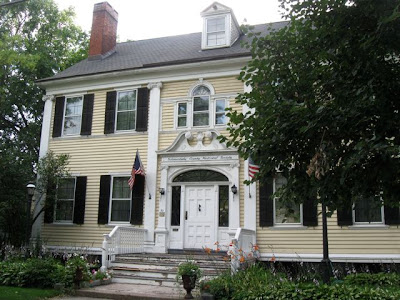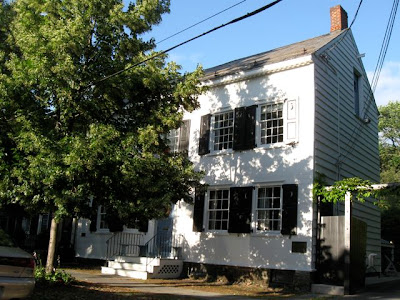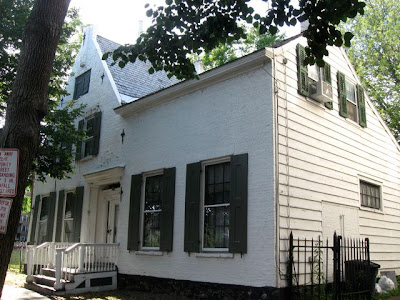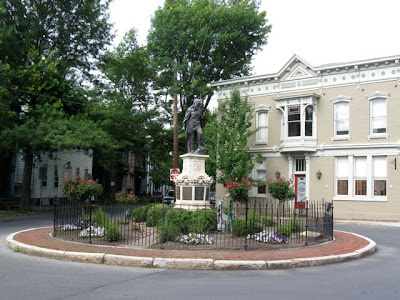 The historical society is housed in an 1985 neo-Georgian home, and a modern addition behind the original building houses its library and archives.
The historical society is housed in an 1985 neo-Georgian home, and a modern addition behind the original building houses its library and archives.Our host, librarian/archivist Katherine Chansky, first led us on a walking tour of Schenectady's historic Stockade District, which sits on the banks of the Mohawk River. The area was first settled in 1664, but all of the original structures were burned to the ground by a French and Mohawk raiding party in 1690. The settlement was rebuilt and quickly became a commercial center: until the Erie Canal opened, settlers heading west had to travel overland from Albany to Schenectady and then resume traveling by ship.
Although the area suffered a devastating fire in 1819, the neighborhood is home to many 18th-century buildings. Two of them, the Hendrick Brouwer House and the Abraham Yates House, may have been built in the late 17th century.
 The Hendrick Brouwer House sits at 14 Front Street, and was known to have existed as of ca. 1705. Some of its cellar beams are 13 inches square, and its foundation walls are 25 inches thick.
The Hendrick Brouwer House sits at 14 Front Street, and was known to have existed as of ca. 1705. Some of its cellar beams are 13 inches square, and its foundation walls are 25 inches thick. Although the building has settled a bit with age (look closely at the doorframe), it is sturdy and well maintained.
Although the building has settled a bit with age (look closely at the doorframe), it is sturdy and well maintained. The Abraham Yates House, which is at 109 Union Street, is a classic Dutch vernacular home; note the street-facing gable end. The portion of the house to the right of the front door is a later addition.
The Abraham Yates House, which is at 109 Union Street, is a classic Dutch vernacular home; note the street-facing gable end. The portion of the house to the right of the front door is a later addition. A look at the side of the Abraham Yates House reveals that it has in fact been the recipient of many additions.
A look at the side of the Abraham Yates House reveals that it has in fact been the recipient of many additions. Another structure of note is the Widow Kendall House at 10 North Ferry Street. The home was built ca. 1790, and for many years was the home of Annie Kendall, who did a good business selling cakes and ale. The home's facade likely assumed its present form during the early 19th century.
Another structure of note is the Widow Kendall House at 10 North Ferry Street. The home was built ca. 1790, and for many years was the home of Annie Kendall, who did a good business selling cakes and ale. The home's facade likely assumed its present form during the early 19th century. Joseph Yates, the first mayor of the city of Schenectady and the fourth governor of New York State (1823-1825), lived at 17 Front Street; Yates apparently didn't believe in patronage, so it's not surprising that he didn't have much of a career in state politics. Yates's three-story home was built in 1760, and the two-story addition on the left housed his law offices.
Joseph Yates, the first mayor of the city of Schenectady and the fourth governor of New York State (1823-1825), lived at 17 Front Street; Yates apparently didn't believe in patronage, so it's not surprising that he didn't have much of a career in state politics. Yates's three-story home was built in 1760, and the two-story addition on the left housed his law offices. The small circular park at the intersection of Front, Ferry and Green Streets marks the site of Queen Anne's Fort, which was built in 1704 and housed approximately 300 soldiers. The statue at the center of the park commemorates Lawrence the Indian, a Christian Mohawk who befriended the Dutch and English and doggedly tracked the French and northern Mohawks responsible for the 1960 raid.
The small circular park at the intersection of Front, Ferry and Green Streets marks the site of Queen Anne's Fort, which was built in 1704 and housed approximately 300 soldiers. The statue at the center of the park commemorates Lawrence the Indian, a Christian Mohawk who befriended the Dutch and English and doggedly tracked the French and northern Mohawks responsible for the 1960 raid.After about 45 minutes, we returned to the historical society for a tour of its museum, library and archives. The museum's exhibits document Schenectady's origins as a Dutch settlement, rise to commercial and industrial preeminence, and efforts to grapple with recent structural changes in the economy. It's a lot larger than it looks from the outside!
We held a brief business meeting in the museum's dining room:
- CAA President Amy Rupert (Rensselaer Polytechnic Institute Archives and Special Collections) outlined CAA's plans to tour of the Franklin D. Roosevelt Presidential Library and Museum in early October and to host a business meeting and event in November.
- I discussed the 2009 Best Practices Exchange and the Partnership for the American Historical Record initiative.
- Susan D'Entremont (Capital District Library Council) noted that the 2009 Capital Region Archives Dinner will be held on October 7. She also highlighted the CDLC's new CDLC Digital Collections site, which makes available digitized materials held by a growing number of libraries, archives, museums, and cultural organizations, and New York Heritage, a portal to digitized materials held by institutions throughout the state.
 Our visit ended with a tour of the library and archives. The research room, which also houses the library, is incredibly airy and inviting. The large picture window in the back of the room overlooks a creek that feeds into the Mohawk River, and the high windows ensure that the space is flooded with light. Modern temperature and humidity controls (which the museum also has) keep the space cool and comfortable for both collections and people.
Our visit ended with a tour of the library and archives. The research room, which also houses the library, is incredibly airy and inviting. The large picture window in the back of the room overlooks a creek that feeds into the Mohawk River, and the high windows ensure that the space is flooded with light. Modern temperature and humidity controls (which the museum also has) keep the space cool and comfortable for both collections and people.I didn't take any pictures of the archives storage area, which is located below the library. The historical society is running a bit short on shelf space (what archives isn't?), but hopes to be able to secure the funding needed to install compact shelving.
This was my first visit to the Schenectady County Historical Society and to the Stockade District, and I was really impressed. The historical society may have a small professional staff, but it's been able to secure a lot of community support and recruit a corps of dedicated and creative volunteers. It sits in the midst of a beautiful and historic neighborhood, and it's pretty plain that the historical society and the neighborhood have a close and mutually beneficial relationship. I'm planning a return visit soon.





No comments:
Post a Comment